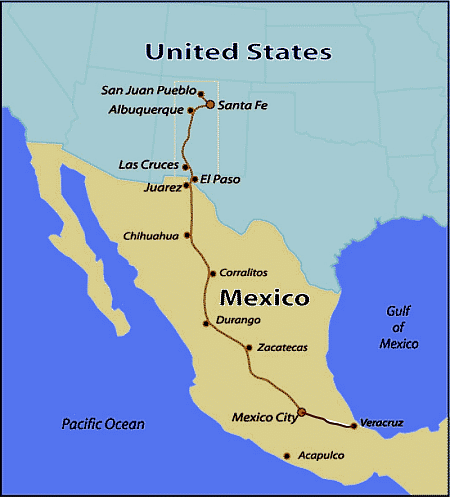By the start of the 16th century, the Aztec Empire had a well developed system of “roads”. However the Aztecs had neither wheels nor beasts of burden to transport themselves or their goods. Obviously this limited transportation to the speed, range and endurance of foot power. Their system of roads was essentially a system of foot trails.
 The Spanish conquistadors found the Aztec roads completely unsuitable for horse traffic and animal-drawn carts. They were forced to undertake expensive re-routing, flattening, widening, and upgrading. In 1550, they started construction of the first section of El Camino Real (the royal highway) linking Mexico City with Spain through the port of Veracruz. The opening of this new road greatly facilitated communication and the transfer of Aztec gold to Spain, and Spanish goods to Mexico’s interior. To counter the threat of bandits, the road was constantly patrolled by soldiers.
The Spanish conquistadors found the Aztec roads completely unsuitable for horse traffic and animal-drawn carts. They were forced to undertake expensive re-routing, flattening, widening, and upgrading. In 1550, they started construction of the first section of El Camino Real (the royal highway) linking Mexico City with Spain through the port of Veracruz. The opening of this new road greatly facilitated communication and the transfer of Aztec gold to Spain, and Spanish goods to Mexico’s interior. To counter the threat of bandits, the road was constantly patrolled by soldiers.
Towns along this route gained new importance. Puebla become the second largest and most important city in New Spain, a position it was to hold for 300 years. In the late 1550s, the road was extended north to Zacatecas, to facilitate transporting gold and silver from that area back to Mexico City and then on to Spain.
El Camino Real was later extended to other important cities and mining districts. By 1600 it reached as far north as Chihuahua and was later extended to Santa Fe (in what is now New Mexico). Many other roads were added to the system to facilitate administration, communication and economic exploitation.
In 1565, the Spanish decided it was safer to ship Asian goods from their colony in the Philippines back to Spain by crossing the Pacific, transshipping the cargo across the breadth of Mexico, and then sailing from Veracruz to Spain. To support this, the El Camino Real was expanded to link Mexico City to Acapulco. This section was only serviceable for pack mules; a road suitable for wheeled vehicles was not completed until well into the 20th century.
For 250 years, Spanish galleons carried Mexican silver to Manila, and returned with spices, silk, porcelain, lacquer ware, and other exotic oriental goods destined for Spain.
The development of Mexico’s transportation system is discussed in chapter 17 of Geo-Mexico: the geography and dynamics of modern Mexico. Ask your library to buy a copy of this handy reference guide to all aspects of Mexico’s geography today! Better yet, order your own copy…
Sorry, the comment form is closed at this time.